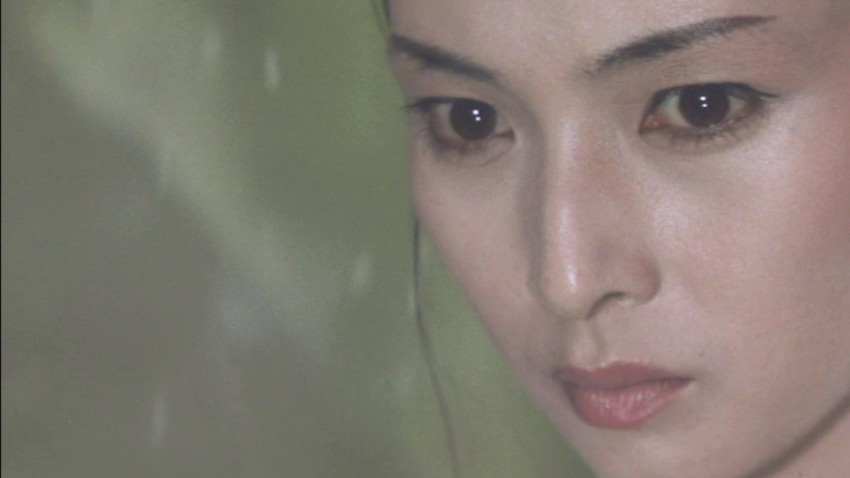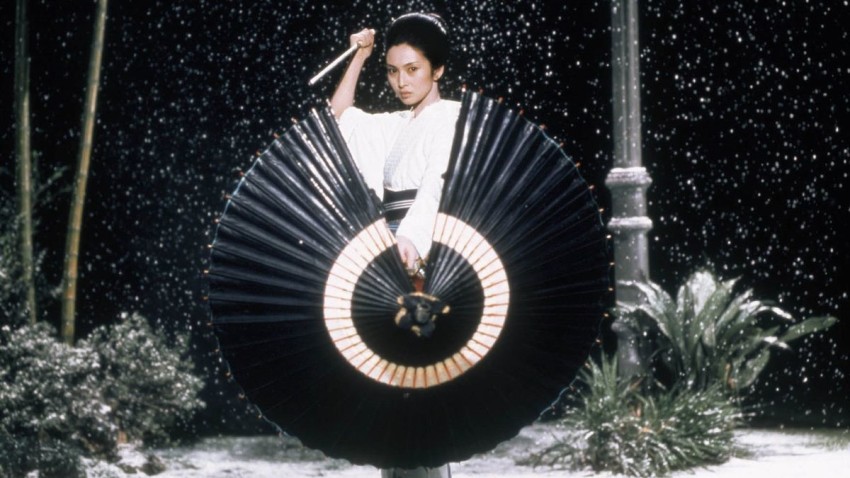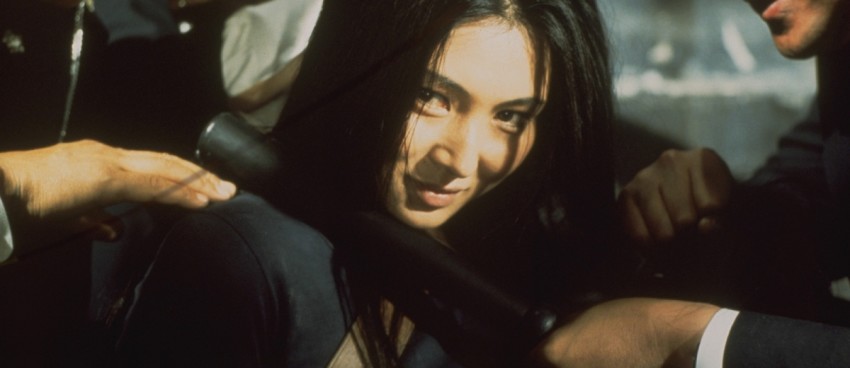Books: Meiko Kaji
March 3, 2018 · 0 comments
By Jasper Sharp.
 If nothing else, Tom Mes’ Unchained Melody: The Films of Meiko Kaji is a timely reminder that in the ever-burgeoning field of books on Japanese cinema, there has been precious little on the stars and sirens who have provided such a large part of the onscreen magic. Only two previous such book-length studies immediately spring to mind. Daisuke Miyao’s Sessue Hayakawa: Silent Cinema and Transnational Stardom (2007) was a scholarly tome that positioned its Japanese-born subject, who spent much of his acting life in Hollywood and made just a handful of films in Japan in the 1930s, within the wider context of non-white performers in silent and pre-war American cinema. Stuart Galbraith’s The Emperor and the Wolf: The Lives and Films of Akira Kurosawa and Toshiro Mifune (2002) explored the dynamics between Japan’s best-known director and the larger-than-life presence at the centre of his best-known films.
If nothing else, Tom Mes’ Unchained Melody: The Films of Meiko Kaji is a timely reminder that in the ever-burgeoning field of books on Japanese cinema, there has been precious little on the stars and sirens who have provided such a large part of the onscreen magic. Only two previous such book-length studies immediately spring to mind. Daisuke Miyao’s Sessue Hayakawa: Silent Cinema and Transnational Stardom (2007) was a scholarly tome that positioned its Japanese-born subject, who spent much of his acting life in Hollywood and made just a handful of films in Japan in the 1930s, within the wider context of non-white performers in silent and pre-war American cinema. Stuart Galbraith’s The Emperor and the Wolf: The Lives and Films of Akira Kurosawa and Toshiro Mifune (2002) explored the dynamics between Japan’s best-known director and the larger-than-life presence at the centre of his best-known films.
Mes provides a welcome addition to the available literature on Japanese screen culture, not only in that his book focuses on an actress, but one who is most commonly associated with the kind of pulp genres such as girl biker flicks, women-in-prison movies, yakuza pictures, horror and manga adaptations that typically fall beneath the scope of scholars and film historians.
Ironically, much of the allure of Kaji’s best-known creations is down to the singular impassivity of her slinky screen presence, in which her taciturn demeanour occasionally gives way to violent outbursts of feline ferocity. In the five-film Stray Cat Rock girl gang series (directed by Yasuharu Hasebe and Toshiya Fujita between 1970-71) and increasingly through the four entries in the astonishing Female Prisoner Scorpion saga (Junya Ito and Yasuharu Hasebe, 1972-73) to the Lady Snowblood diptych from 1973 and 1974, adapted by Toshiya Fujita from Kazuo Koike’s Meiji-period manga tale of revenge, she famously barely utters a word, conveying a mixture of poise, dignity and resistance in the face of patriarchal oppression by way of little more than a defiant stare.
 Probably best known is her character in the two Lady Snowblood films (as Mes explains, the original title Shurayuki-hime puns on the Japanese for Snow White, Shirayuki-hime, and the word shura for ‘courage’). A kimono-clad angel of vengeance, who goes in search of the men responsible for murdering her father and sexually assaulting her mother, was reworked by that cinematic magpie Quentin Tarantino in his Kill Bill films (2003/2004). There are many things one can say about Tarantino, but it is likely that few would have linked Lucy Liu’s graceful assassin directly back to her original source had it not been for the director’s inclusion of ‘Shura no hana’ and ‘Urami-bushi’, the theme songs for both Lady Snowblood and the Scorpion titles respectively, as sung by Kaji herself.
Probably best known is her character in the two Lady Snowblood films (as Mes explains, the original title Shurayuki-hime puns on the Japanese for Snow White, Shirayuki-hime, and the word shura for ‘courage’). A kimono-clad angel of vengeance, who goes in search of the men responsible for murdering her father and sexually assaulting her mother, was reworked by that cinematic magpie Quentin Tarantino in his Kill Bill films (2003/2004). There are many things one can say about Tarantino, but it is likely that few would have linked Lucy Liu’s graceful assassin directly back to her original source had it not been for the director’s inclusion of ‘Shura no hana’ and ‘Urami-bushi’, the theme songs for both Lady Snowblood and the Scorpion titles respectively, as sung by Kaji herself.
The songs reveal a crucial component to a performer who spent much of the screen time in the films in which she appeared suffering in stoic silence: the impassioned internal refrain of a woman condemned. The Kill Bill endorsement has certainly been a key point in the marketing of subsequent DVD or Blu-ray releases of Kaji’s original excursions, but it also led to a surge in interest in Kaji’s singing career in Japan, with her most-celebrated hits reissued on a compilation CD in the direct aftermath of the release of Tarantino’s film.
As well as including a full discography, Mes devotes his final chapter, entitled ‘Love Songs of Vengeance’ to Kaji’s musical career, but it is her film work that naturally dominates the discussion throughout the rest of the book. Born in 1947, she began her career modelling for teen fashion magazines, before she was spotted by Nikkatsu and joined the studio in 1965. Initially she was cast in fairly minor roles, with appearances in no less than seventeen films in her first two years as an actress, still billed under her birth name of Masako Ota. Nevertheless, it was clear that the studio has little idea what to do with this fresh-faced, chubby-cheeked girl-next-door type.
While most tend to look back at Nikkatsu during this period as focussed on its “borderless” action, gangster and crime films featuring such icons of cosmopolitan cool as Akira Kobayashi, Jo Shishido and Tetsuya Watari, the company were just as active in targeting women audiences, with a slew of female-fronted romances, musicals and contemporary dramas. The cheerily winsome Sayuri Yoshinaga was the studio darling du jour, fronting such films as Kirio Urayama Foundry Town (1962) and Katsumi Nishikawa’s 1963 adaptation of Yasunari Kawabata’s The Izu Dancer. Indeed, Ota made her debut appearing down at the bottom end of the cast list in another Yoshinaga vehicle directed by Nishikawa, Sad Song of Parting (1965). She also played in a small part alongside Nikkatsu’s top actress in Monument to the Girls’ Corps (1968), an uncharacteristic foray into wartime melodrama by director Toshio Matsuda based on a true story about a team of Okinawan high-school girls trained to fend off the forthcoming Allied Invasion at the tail end of World War 2. However, it became immediately clear that the young actress did not comfortably fit into this particular mould.
 Ota’s transformation came in 1969, with Masahiro Makino’s Remnants of Japanese Chivalry, a yakuza film in which she adopted the familiar screen name of Meiko Kaji for the first time. There had been hints in previous works of the icy screen persona that was soon to become her stock in trade, notably her role in Retaliation (1968) by Yasuharu Hasebe, one of the directors who would be symptomatic of the grittier approach Nikkatsu were veering towards in the late 1960s and a figure who would play a key role in the Kaji branding.
Ota’s transformation came in 1969, with Masahiro Makino’s Remnants of Japanese Chivalry, a yakuza film in which she adopted the familiar screen name of Meiko Kaji for the first time. There had been hints in previous works of the icy screen persona that was soon to become her stock in trade, notably her role in Retaliation (1968) by Yasuharu Hasebe, one of the directors who would be symptomatic of the grittier approach Nikkatsu were veering towards in the late 1960s and a figure who would play a key role in the Kaji branding.
As Mes writes, Hasebe’s Stray Cat Rock: Sex Hunter (1970), the third instalment of the classic girl gang series, was the title “that sees the birth of Kaji Cool, delivering the blueprint for the outlaw persona of Female Prisoner Scorpion and Lady Snowblood with which she would forever remain associated” and a film that also “signalled a change in the way women were portrayed in Japanese popular cinema.” Interestingly, the stylish outfits that became such a core component of the Kaji package were chosen by the actress and director together, both of whom scoured the most glitzy department stores in Tokyo with whom Nikkatsu had deals.
After taking the lead in titles like Teruo Ishii’s yakuza-horror mashup Blind Woman’s Curse (1970) and the aforementioned Stray Cat Rock series (although not the first title, Female Boss, in which she was billed beneath pop singer Akiko Wada), Kaji famously left the studio when it switched to its Roman Porno line in 1971. As Mes emphasises, here was a star who took a notoriously uncompromising stance to her career, rarely doing nude scenes and particularly choosy about the parts she played.
 While Kaji will always be indelibly associated with Female Prisoner Scorpion and Lady Snowblood, Mes also details her subsequent roles, notably in Kinji Fukasaku’s raucous yakuza films and a trio of titles by Yasuzo Masumura released from 1975 to 1978, right up to her last film appearance in Toru Hayashi’s The Women of the Inner Palace in 2006.
While Kaji will always be indelibly associated with Female Prisoner Scorpion and Lady Snowblood, Mes also details her subsequent roles, notably in Kinji Fukasaku’s raucous yakuza films and a trio of titles by Yasuzo Masumura released from 1975 to 1978, right up to her last film appearance in Toru Hayashi’s The Women of the Inner Palace in 2006.
Each chapter focusses on a different phase of her evolving career, ending with a concise profile of the director that defined it: Makino, Hasebe, Ito, Fujita, Fukasaku and Masumura. There’s also a chapter devoted to her sizeable body of work in television. If Kaji’s filmography looks relatively sparse in comparison to some of her contemporaries, it is because during her big-screen heyday, she was also appearing regularly in small-screen serials such as Edo Dragnet (between 1970-73) and Warring States Rock (1973), and later Onihei hakacho (1989-97).
As one of the pair of new titles heralding the launch of Arrow Books, a new publishing line from the distributors of many of Kaji’s films, Unchained Melody presents a different proposition to Andrew Osmond’s Ghost in the Shell book in that is not solely focussed on one film but spans an entire career. As such, it’s slightly longer, its 155 pages more tightly laid out and there is a filmography, discography, bibliography and index included. There’s also a wealth of visual material here, from stills, posters, promo pics, behind-the-scenes shots and album covers.
I should point out now that as Mes’ colleague and co-editor on Midnight Eye for 15 years, I’m quite aware how long this particular passion project has been in gestation. The book actually begins with a prologue detailing the author’s star-struck meeting with his subject in Tokyo way back in 2006, kicking off proceedings with a wonderful first-person portrait of the lady.
Nevertheless, there’s a few minor mistakes and misconceptions that I feel it’s my critical duty to point out. Nikkatsu’s “New Action” line didn’t begin in 1970, as stated, but in 1968 with the release of Toshio Masuda’s Gangster VIP. Atsushi Yamatoya, the screenwriter of Stray Cat Rock: Sex Hunter didn’t singlehandedly pen the Seijun Suzuki classic Branded to Kill (1967), but was part of an eight-man team of contributors. I personally also wouldn’t put Ruriko Asaoka in the same ballpark of “prim young ladies” as Sayuri Yoshinaga. She was far more versatile and charismatic than she is credited as being here.
Another admittedly minor gripe is that not all of the filmography lists English titles. It is true that not every Japanese film is assigned an English release title, although if you look through Nikkatsu’s sales catalogues from this period, most do. Even so, it would surely make sense to provide translations for those that don’t, and to stick with the release titles of those that have been distributed abroad. For example, Arrow themselves have actually released Hasebe’s Massacre Gun on home video, but the title is given as Slaughter Gun in the text, while the third Female Prisoner Scorpion film, Beast Stable, is here rendered as Den of the Beast.
Given that relatively little of Kaji’s filmography has made it overseas, the scope of the book is impressive. It is great to learn more about Kaji’s mid-career collaborations with Masumura, resulting in such titles as Double Suicide at Sonezaki (1978), for example, and her appearance in the Warring States Rock TV series, “a sort of period version of Stray Cat Rock” directed by Hasebe. It would have been nice to have a little more about her roles during her stint at Nikkatsu though, especially as the films in which she played before hitting the big-time form the bulk of her filmography.
Overall, however, Unchained Melody evokes a really exciting period in Japanese cinema and pop culture. Who wouldn’t wish they could have been present at Kaji’s first live singing performance, appearing as part of the ‘Shinjuku Outlaw Show’, stage-directed by Toshiya Fujita and featuring Joe Yamanaka of the legendary Flower Travellin’ Band and Butoh maestro Tatsumi Hijikata? And who wouldn’t want to see a title called Mini Skirt Lynchers (1969)? Arrow, I hope you are listening…
Jasper Sharp is the author of The Historical Dictionary of Japanese Cinema.
Leave a Reply